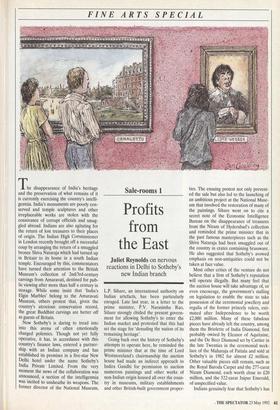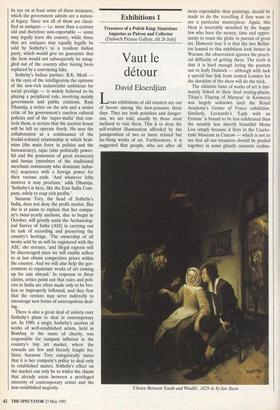FINE ARTS SPECIAL
The disappearance of India's heritage and the preservation of what remains of it is currently exercising the country's intelli- gentsia. India's monuments are poorly con- served and temple sculptures and other irreplaceable works are stolen with the connivance of corrupt officials and smug- gled abroad. Indians are also agitating for the return of lost treasures to their places of origin. The Indian High Commissioner in London recently brought off a successful coup by arranging the return of a smuggled bronze Shiva Nataraja which had turned up in Britain' to its home in a south Indian temple. Encouraged by this, commentators have turned their attention to the British Museum's collection of 2nd/3rd-century carvings from Amaravati, destined for pub- lic viewing after more than half a century in storage. While some insist that 'India's Elgin Marbles' belong to the Amaravati Museum, others protest that, given the country's atrocious conservation record, the great Buddhist carvings are better off as guests of Britain.
Now Sotheby's is daring to tread into into this arena of often emotionally charged polemics. Though not yet fully operative, it has, in accordance with this country's finance laws, entered a partner- ship with an Indian company and has established its premises in a five-star New Delhi hotel under the name Sotheby's India Private Limited. From the very moment the news of the collaboration was announced, a section of the intelligentsia was incited to unsheathe its weapons. The former director of the National Museum,
Sale-rooms 1
Profits from the East
Juliet Reynolds on nervous reactions in Delhi to Sotheby's new Indian branch
L.P. Sihare, an international authority on Indian artefacts, has been particularly enraged. Late last year, in a letter to the prime minister, P.V. Narasimha Rao, Sihare strongly chided the present govern- ment for allowing Sotheby's to enter the Indian market and protested that this had set the stage for 'denuding the nation of its remaining heritage'.
Going back over the history of Sotheby's attempts to operate here, he reminded the prime minister that at the time of Lord Westmoreland's chairmanship the auction house had made an indirect approach to Indira Gandhi for permission to auction numerous paintings and other works of non-Indian origin housed all over the coun- try in museums, military establishments and other British-built government proper- ties. The ensuing protest not only prevent- ed the sale but also led to the launching of an ambitious project at the National Muse- um that involved the restoration of many of the paintings. Sihare went on to cite a secret note of the Economic Intelligence Bureau on the disappearance of treasures from the Nizam of Hyderabad's collection and reminded the prime minister that in the past famous masterpieces such as the Shiva Nataraja had been smuggled out of the country in crates containing brassware. He also suggested that Sotheby's avowed emphasis on non-antiquities could not be taken at face value.
Most other critics of the venture do not believe that a firm of Sotheby's reputation will operate illegally. But many feel that the auction house will take advantage of, or even encourage, the government's stalling on legislation to enable the state to take possession of the ceremonial jewellery and regalia of the former princely rulers, esti- mated after Independence to be worth £2,000 million. Many of these fabulous pieces have already left the country, among them the Briolette of India Diamond, first probably owned by Eleanor of Aquitaine, and the De Beer Diamond set by Cartier in the late Twenties in the ceremonial neck- lace of the Maharaja of Patiala and sold at Sotheby's in 1982 for almost £2 million. Other valuable pieces still remain, such as the Royal Baroda Carpet and the 277-carat Nizam Diamond, each worth close to £20 million, and the 522-carat Jaipur Emerald, of unspecified value.
Indians genuinely fear that Sotheby's has its eye on at least some of these treasures, which the government admits are a nation- al legacy. Since not all of them are classi fled as antiques — i.e. more than a century old and therefore non-exportable — some may legally leave the country, while those that are antiques may equally legally be sold by Sotheby's to a resident Indian party, which would give no guarantee that the item would not subsequently be smug- gled out of the country after having been replaced by a convincing fake.
Sotheby's Indian partner, B.K. Modi in the eyes of the intelligentsia the epitome of the new-rich industrialist ambitious for social prestige — is widely believed to be playing a peripheral role, involving mainly government and public relations. Ram Dhamija, a writer on the arts and a senior critic of his government's careless cultural policies and of the 'super-mafia' that con- trols them, is certain that the auction house will be left to operate freely. He sees the collaboration as a continuance of the feudal-colonial relationship in which brah- mins (the main force in politics and the bureaucracy), rajas (also politically power- ful and the possessors of great treasures) and banias (members of the traditional merchant community who dominate indus- try) acquiesce with a foreign power for their various ends. 'And whatever lofty motives it may proclaim,' adds Dhamija, `Sotheby's is here, like the East India Com- pany, solely to reap rich profits.'
Suzanne Tory, the head of Sotheby's India, does not deny the profit motive. But she is at pains to explain that her compa- ny's twice-yearly auctions, due to begin in October, will greatly assist the Archaeolog- ical Survey of India (ASI) in carrying out its task of recording and preserving the country's heritage. 'The ownership of all works sold by us will be registered with the ASI,' she stresses, 'and illegal exports will be discouraged since we will enable sellers to at last obtain competitive prices within the country. And we will also help the gov- ernment to repatriate works of art coming up for sale abroad.' In response to these claims, critics point out that rules and poli- cies in India are often made only to be bro- ken or improperly followed, and they fear that the venture may serve indirectly to encourage new forms of unscrupulous deal- ing.
There is also a great deal of anxiety over Sotheby's plans to deal in contemporary art. In 1989, a single Sotheby's auction of works of well-established artists, held in Bombay in the name of charity, was responsible for rampant inflation in the country's tiny art market, where the rewards are few and fiercely fought for. Since Suzanne Tory categorically states that it is her company's policy to deal only in established names, Sotheby's effect on the market can only be to widen the chasm that already exists between a privileged minority of contemporary artists and the non-established majority.



































































 Previous page
Previous page